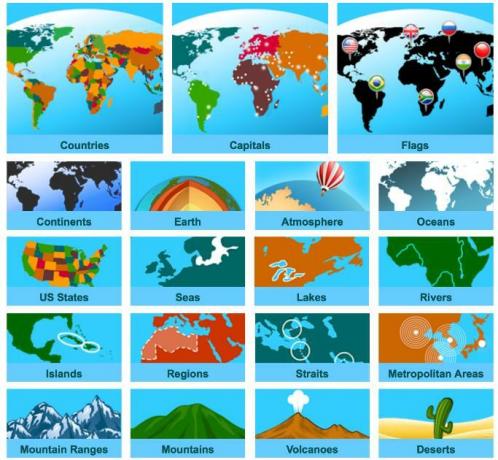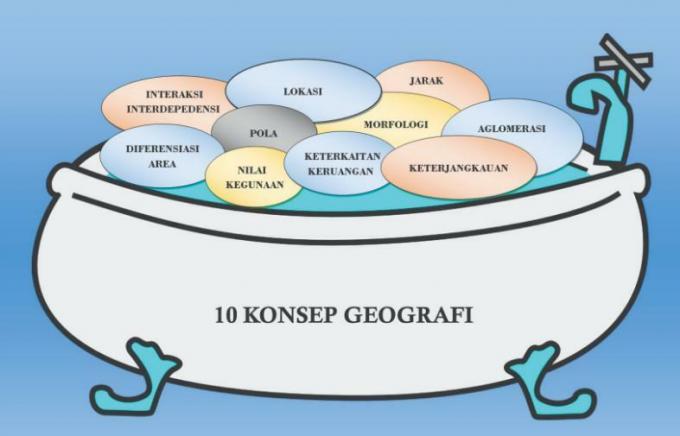10 Basic Concepts of Geography and Examples (Summary)
Loading...
In practice, geography has its own concept that is closely related to social problems that exist in society.
Therefore, the study of this science always has the concept of geography that continues to grow.
The point of view of geography on a phenomenon requires a number of basic and essential concepts that are interconnected (Marhadi, 2014).
Various basic concepts of geography according to Suharyono and Moch Amien (1994) are the most important concepts to describe the structure of science itself.
Before you know the concept of geography, first know the meaning of the concept of geography below.
Understanding the Concept of Geography

The concept of geography is a way of looking at geography on the earth as a place where living things live, not as a way of making an inventory of all the phenomena that occur.
There are also 10 basic concepts of geography that you need to know, including:
- Location concept
- Distance
- Morphology
- Affordability
- Pattern
- Agglomeration
- Usability value
- Interaction and interdependence
- Area differentiation
- And the relationship of the room.
An explanation of each concept will be discussed in the review below.
Geography Concept

list of contents
1. Distance Concept
The concept of distance relates to the length of one object with another object.
In this one concept, it is also divided into two parts, namely absolute distance and relative distance.
a. Absolute Distance
Is the distance in certain units as well as the actual distance.
b. Relative Distance
At this distance one is described in 3 maps, namely:
- Isochronic maps relate distance to time;
- Isophodic maps relate distances to costs;
- As well as an isotacic map that connects areas with the same transport speed.
The concept of distance is associated with the benefits obtained so that humans will tend to take distance into account.
An example of relative distance is that the price of land increases when it is closer to the city center than the price of land in rural areas.
2. Location Concept
The concept of location is also often referred to as the concept of location which is the main concept since the beginning of the growth of geography, which has become a special feature of geography.
Basically, location is also divided into two parts, namely absolute location and relative location.
a. Absolute Location
It is a definite location on the earth's surface that can be determined using a latitude and longitude coordinate system.
The location of this one is absolute and will not change the coordinates.
b. Relative Location
Advertisement
At this one location it is dynamic or in geography it is also called a geographical location which is connected to a strategic point of a place.
The value of the high and low of an object will be influenced by other objects that are related to the first object that is the point of attention.
For example, the relative location in a cold area means that people tend to dress thickly/warmly.
3. Affordability Concept
The concept of affordability is the ease or not of a location being reached from another location.
This affordability depends on the distance traveled and is measured by physical distance, time, cost, and various terrain obstacles.
For example:
- The affordability of the city of Jakarta – Semarang can use a plane.
- Jakarta – Bandung by train.
4. Morphological Concept
In this morphological concept, it is explained that the land surface of the earth is the result of a decrease/uplift of an area through geological processes, such as erosion or sedimentation.
The concept of this morphology is also related to the form of land affected by deposition, erosion, land use, soil thickness, and water availability.
The shape of the plains with a slope of no more than 5 degrees is the right area to be used as settlements and agricultural businesses or other businesses.
This morphological concept is related to the shape of the earth's surface as a result of natural processes and its relation to human activities.
For example, the shape of the land will be related to erosion and deposition, land use, water availability, soil layer thickness, and others.
5. Agglomeration Concept
The concept of agglomeration is a grouping of various human activities in adapting to their environment such as agricultural activities, settlements, trade, and others.
Some geographic facts that can be studied using the concept of agglomeration, especially those concerning the human aspect.
For example, some rich people choose to live in elite areas, while poor people live in slum areas.
6. Pattern Concept
The concept of this pattern is related to the distribution of phenomena on the earth's surface. Examples include natural phenomena (vegetation distribution, river flow, soil types, and rainfall) to socio-cultural phenomena (population distribution, settlements, and livelihoods).
The concept of pattern can be seen from the pattern of river flow which is related to the geological structure and rock type.
The pattern of population settlements is related to roads, rivers, land forms and others.
7. Concept of Interaction & Interdependence
The concept of interaction is a reciprocal relationship between two or more areas that can produce new realities, appearances, and problems.
In the concept of interaction and interdependence, it is related to dependence on each region in meeting its own needs but requires relationship with other regions so that it will lead to interactions (reciprocal) in the form of services, the flow of goods, the spread of ideas, communication, and others. other.
For example, the interaction between the city and the village takes place because of differences in natural potential.
The village will produce raw materials while the city produces industrial products.
8. Value Use Concept
The concept of utility value is related to human interaction with the environment which will provide an important value in certain aspects.
You can see this concept from the green open space of a city or residential area that has usefulness in geography.
9. Room Linkage Concept
Geography is a synthetic science which means the interrelatedness of physical phenomena with humans which characterizes an area with a pattern of integration or synthesis that is clearly visible in regional studies.
The broad scope of the object of this study of geography can have an impact on the subjects and sub-topics presented in geography lessons at school.
An area can develop because of the existence of links with other regions or the existence of interrelationships between regions in meeting the needs and social needs of the population.
For example:
If examined through a map, then there is spatial conservation or regional linkages between regions A, B, C and D.
Floods and droughts in Jakarta are also closely related to the transfer of land functions in the upstream area around the Puncak - Cianjur area.
10. Area Differentiation Concept
This concept looks at the different physical, resource, and human conditions in the region, region, or region.
Various geographical phenomena and problems scattered in space have different characteristics or characteristics.
You can see an example of this one concept from similar urban problems in other cities Different solutions require different problem solving alternatives according to the characteristics or characteristics his room.
X CLOSE
Advertisements
X CLOSE
Advertisements
